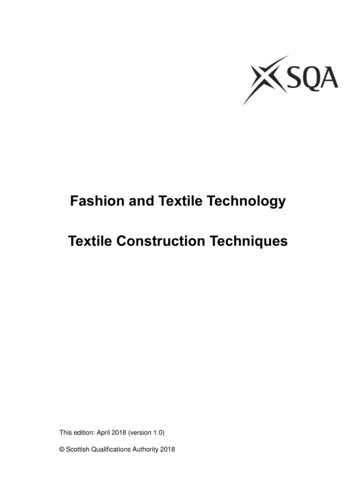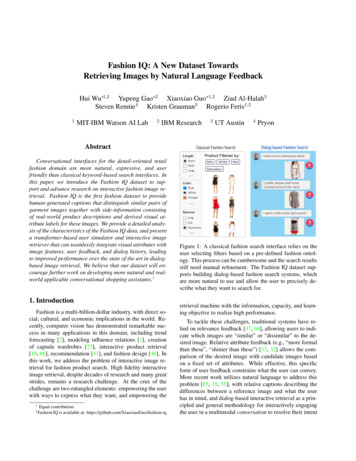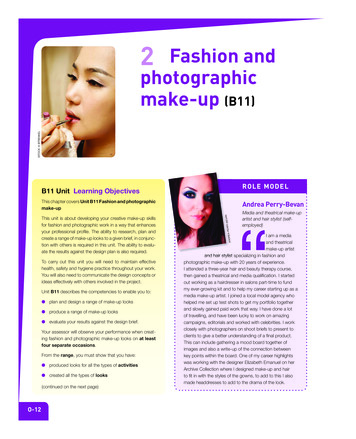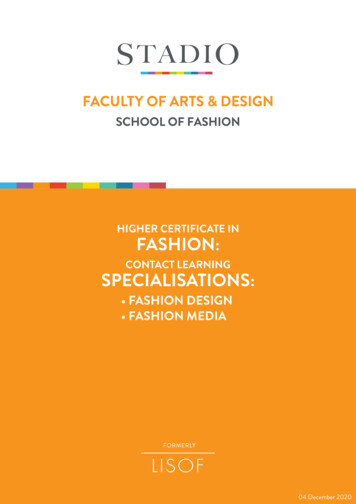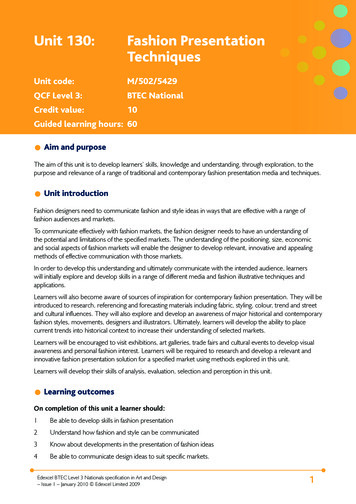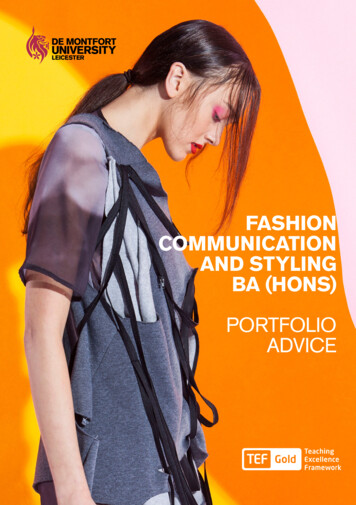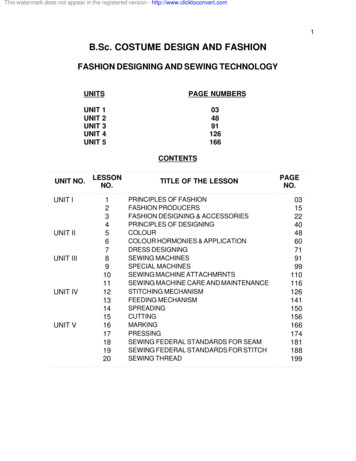
Transcription
Textile Craft, Textile and Fashion Design, Textile Technology, Textile Management & Fashion CommunicationSpecial Edition: Sustainability &Innovation in the Fashion Field
The Nordic Textile Journal is a peer reviewed international journalpublishing high-quality articles dedicated to research and artisticdevelopment related to textiles and fashion.The Textile Research Centre, CTFThe Swedish School of TextilesUniversity of BoråsSE-501 90 BORÅSSWEDENTel:Fax:E-mailWeb: 46 33 435 43 93 46 33 435 40 09CTF@hb.sewww.hb.se/ths/ctfThe Journal considers only manuscripts that have not beenpublished elsewhere. The Journal is published in English by theCTF Centre of Textile Research in Borås, Sweden. Copyright is bythe publisher and the authors.The Journal is issued in printed form, normally one issue annually.Articles from earlier issues will also be available in electronic formvia BADA, the Borås Academic Digital Archive http://bada.hb.se/handle/2320/1556Manuscripts in the following categories will be considered forpublication:PublisherCTF Publishing1. Research articles: A research article is a regular article whichaims to present new findings in textile and fashion research.Executive EditorHåkan Torstensson2. Articles on artistic development: An article on artisticdevelopment aims to present artistic progress and mayrelate to practice-based design research, designmethodology or novel achievements in textile art and craft.Assistant Executive EditorKatrin TijburgEdited byKarin M EkströmAgneta Nordlund AnderssonKatrin TijburgHåkan TorstenssonKarin SüldLisbeth Svengren HolmClemens ThornqvistGraphic DesignMalin NyströmPublicationISSN 1404-2487Photograph coverAnna SiggeDesign by Lisa WennöPrepress and Printing HouseEtcetera Offset AB, Borås, SwedenOfficial sponsor 20123. Notes: A note is a short article, which aims to reportnew findings.4. Review articles: A review article aims to present alreadyexisting findings and may be a book review or anexhibition review.5. Conference articles: Upon agreement with conferenceorganizers, selected conference contributions may bepublished by the Journal in a special section.Areas covered by the Nordic Textile Journal include several aspectsrelated to textiles and fashion, such as design and arts, engineeringand technology, business, management and socio-economicissues, as well as cross-disciplinary and transdisciplinary issues.
EDITORFashion Function Future (F:3) - a research programmeLisbeth Svengren Holm2RESEARCH ARTICLESCrafting Smart Textiles – a meaningful way towardssocietal sustainability in the fashion field?Kirsti Kuusk, Oscar Tomico, Geert Langereis, Stephan Wensveen6The Worn, The Torn, The Wearable: textile recycling in Union SquareDavid Goldsmith16Multifarious Approaches to Attain Sustainable FashionNidhi L. Sharda, Mohan Kumar VK30Rethinking Available Production Technologies– the case of a thermally insulting footwear conceptNils-Krister Persson, Anna-Carin Jonsson38Ideas For Another WorkwearDaniel Larsson50Proactive Fashion Design for Sustainable ConsumptionKirsi Niinimäki60HeadCrowd: visual feedback for designBritta Kalkreuter, David Robb70Value Innovation and Demand Chain Management– keys to future success in the fashion industryDag Ericsson, Malin Sundström82TEXTILE NOTESAmbience’1192Interactivity94From the Brundtland Report to the Global Organic Textile Standard100EDITORIAL BOARDThe Editorial Board for the Nordic Textile Journal108CONTRIBUTORSNotes for authors111
Fashion Function Future (F:3)– a research programme2EXIT 2012 Photo: Anna Sigge. Designers: left Sofia Bahlner. Right from the top: Ina Hjelte, Linnea Bågander, Johan NordbergLisbeth Svengren HolmProfessor and Head of F:3Textile JournalWe are all affected by fashion: as individuals when we use clothes and other productsto create an identity and an image and as consumers participating in the wheel ofconsumption and economy. As researchers, we try to understand fashion and its actorsand how research can contribute to a better society and prosperous industries. Thisissue of the Nordic Textile Journal presents both articles based on research conductedat the University of Borås and articles from other researchers who share our interest insustainable fashion and the textile industry.Once upon a time, Borås was well-known as a cluster for the Swedish textile industry.Although many textile and fashion businesses closed down as a result of the decline ofthe industry in the 1970’s, the Borås region still hosts many fashion and textile businesses and is the home of the only fashion incubator in Sweden (Modeinkubatorn).Together with the Swedish School of Textiles, the University of Borås and other educational organisations focusing on fashion and textiles this region has once again becomea hotbed for a dynamic fashion and the textile sector. Thus, it is no coincidence that aresearch programme called Fashion Function Future (F:3) was initiated at the Universityof Borås in 2010.Fashion Function Future (F:3) – is a programme for research and artistic development,addressing issues and topics ranging from artistic design to distribution logistics, as wellas the marketing and management of fashion and textile companies, where sustainabilityis a shared concern. The programme is based on an interdisciplinary environment thatsupports the development and balancing of artistic expressions, design methodology,technology and management, all related to the field of fashion and textiles. Severaldepartments at the University of Borås collaborate to achieve this interdisciplinaryapproach and contribute with the knowledge required to shape F:3.Although we are based in Borås, where tradition associates fashion with clothing andtextiles, we realise the term fashion is more complicated than that and that it needsto be further investigated for our readers to fully understand the intention behind ourprogramme. Our research is Future oriented, but the in-between term Function alsoneeds some explanation, which we will come back to below.To explain why fashion is not only the study of dress and clothing, Kawamura (2005, p.1) coined the term “Fashion-ology”, which she defines as “a sociological investigationof fashion, and it treats fashion as a system of institutions, that produces the conceptas well as the phenomenon/practices of fashion”. Fashion is an immaterial conceptand clothes are the materialized objects of this concept. In this sense, Kawamura refersto the actors who are part of a specific system that defines what is defined as fashionand what is not. For clothing to become fashion, it is not enough that a collectionThe Nordic Textile Journal3
of clothes has been shown on the catwalk. The participation ofmultiple actors is required for something to be defined as fashion.Hence, fashion is a sociological phenomenon, a socially constructedprocess, because a social context is required. It is also one reasonwhy research in fashion primarily takes place within the field ofsociology and considers fashion a cultural phenomenon.Although the fashion industry is an old industry, research focusing on fashion businesses from a management perspective israther young. Parallel to the emergence of brand managementin the 1980’s, an interest emerged in the marketing of fashion(c.f Rogers and Gamans, 1983; Hines & Bruce, 2001). Thishappened in a time when fast-fashion took off and companiessuch as H&M and Zara conquered fashion markets globally. Thistriggered Teri Agins to write her book The End of Fashion: theMass Marketing of Clothing in 1999. However, fashion marketingcontinued to grow as a subject; especially, luxury brands raisedan interest among brand researchers in the late 1990’s and havecontinued to do so after 2000 (Kapferer, 1997; Moore & Birtwistle,2004; Okonkwo, 2009; Radon, 2010). Business schools such asBocconi in Milan, Essec outside Paris and the London BusinessSchool even initiated special Master’s programmes addressingluxury branding.In 2009, the Swedish School of Textiles started a new Master’sprogramme in Fashion Management and Marketing in collaboration with the London College of Fashion, where the Master’sprogramme in Fashion Management at the LCF was a source ofinspiration. This caused a need to strengthen research in fashionfrom a management and marketing perspective and also a needto reinforce the research profile in textile and fashion alreadyestablished across several departments at the University ofBorås. This collaboration came to form the foundation for theresearch programme Fashion Function Future.Fashion is, as stated by Kawamura (2005), a system driven bycertain fashion companies, designers, trend institutes, media,modelling agencies, PR agencies, and consumers – intertwinedand interdependent. The system allows some clothes to beembraced and to become “fashion” and while others fail andare, probably, forgotten. In this sense, Kawamura distinguishesbetween fashion production and fashion consumption on theone hand and production and consumption of clothing on theother. A fashion company creates garments of a specific design,which will be produced at a certain quality level, at a certainprice, and will reach the market and the customers as efficientlyas possible. Hence, it is a quite traditional enterprise focusedon technology, materials, distribution, finances and, of course,4The Nordic Textile Journaldesign and creativity. Therefore, at the different departments ofthe University of Borås, we stand to benefit from research froma broad perspective in the fields of management, leadership,marketing and technology and are also able to apply it to thefashion and textile sector. However, in order to understand howdifferent management models are to be interpreted in connectionwith the fashion industry, we need to recognize the fashionmarket as an aesthetic market and one which comes withcertain particularities (Entwistle, 2009).The importance of being part of a specific culture and of participating in specific events is not unique to the file of fashion.Principally, similar institutional systems for e.g. producers,designers, media, PR-agents and consumers are also valid forother product categories that are part of what we describedabove as an institutionalized system and what could be referredto, in a wider sense, as aesthetic cultures. The products inquestion are usually ones we do not consume solely for theirfunction, as we do e.g. with a chair to sit on or a table to eatat, but also for the value of a certain aesthetic, which in manycases is endorsed by a famous designer brand and legitimizedby defined trends. Researchers need to have an understandingfor how an aesthetic culture affects the companies and peoplewho are part of it, while these companies also experience thesame management issues as any other company – in principle.Through participation and interaction in research projects andat seminars organized within F3, researchers from the fields offashion and textile design, technology, materials, managementand marketing are given opportunities to share knowledge andexperience with practitioners from the field.All clothes are not fashion: not only because they are not part ofthe fashion system, but also because they are worn primarily fortheir function. This is not to say that aesthetics is not relevant forfunctional products; on the contrary, they are significant to thewearers and users both as identity markers and because of differentsignal features provided by the appearance of the products.This applies to everything from workwear and sportswear touniforms, traditional folk costumes and other textile products.But what is considered function and what is considered fashionchange over time. Sportswear used to be worn primarily for itsfunctionality, whereas today a lot of sportswear is affected bythe fashion concept and sportswear companies compete directlywith fashion companies. Manufacturers of products focusing onfunctionality have collaborated with the University of Borås fora long time regarding materials, design and supply chain issues.This research also provides a foundation for developing researchin F:3 related to fashion products.Fashion is one of the largest industries worldwide, prospering atthe very heart of consumer society, and provides great opportunities for newly industrialized countries, while it also challengesour capability to solve many of the environmental issues relatedto it that cause severe problems. Fashion is responsible for someof the obstacles to achieving a sustainable society and environment. There are problems along the entire chain of productionof garments and other products essential to the world of fashion,from issues related to the cultivation of fibres, pollution of soiland water, and exploitation of the work force and animals, allthe way to issues related to consumption of fashion and clothing.The task of solving all these problems is overwhelming. Hence,the Future for the fashion and textile companies, as well as forthe consumers, holds many great challenges.fashion design companies, leadership in fashion design companiesand for fashion etailers, innovation in the field of fashion, aswell as studies of consumer behaviour from a sustainabilityperspective. In the textile and fashion value chain, from ideas tocustomers and beyond, the decisive stage is in the design process,which combines artistic skills and functional considerations inorder to make fashion products logistically manageable, attractiveto customers, and resourceful from an environmental and sustainability point of view. For more information about on-goingprojects, please visit our homepage: http://www.hb.se/f3In the creation of the new research programme in 2010, thechallenges and opportunities facing the fashion industry guidedour ideas for different projects. When defining sustainability,three areas were considered: environment, ethics, and economy.Although it seems the industry focuses mainly on the creationof a luxurious and glamorous world, there is an interest, forcedor not, among fashion companies for improving matters andsolving problems. Some leading companies of the industry havejoined forces and have started to measure improvements indifferent ways, e.g. through the Higg-index. This is of course anecessity if they want to survive in the long run.Entwistle, Joanne. 2009. The Aesthetic Economy of Fashion.Oxford. Berg Publishers.Fashion is a global industry to a great extent and one whereeven very small companies from e.g. Sweden have to deal withproduction both in other European countries and the Far East.Digital development is changing the ways in which companiesreach their consumers and this is an opportunity for smallcompanies, although it is not quite as easy as it is sometimesseems. There has been some discussion on the existence of“the Swedish Fashion Miracle” based on the success of severalSwedish fashion brands (Falk, 2011). Rather than being amiracle, this is the result of creativity and hard work. Growing tobecome an international company is a great challenge to a smallenterprise. Thus, economic sustainability is a subheading in ourdefinition of sustainability and also the topic of some of the research projects within the Fashion Function Future programme.Kawamura. Yuniya. 2005. Fashion-ology: An Introduction toFashion Studies. Oxford, Berg Publishers.Although we cannot present all topics, we have initiatedresearch projects addressing development of fibres that areharmless to the environment, aesthetics of new materials,organization of local production, new business models based onre-design of old garments, the creation of more efficient supplychains without returns, the international growth of SwedishRogers, D. S., Gamans, L. R. (1983). Fashion: a MarketingApproach. New York: CBS College PublishingReferencesAgins, Teri. 1999. The end of Fashion: the Mass Marketing ofClothing Business. New York: William Morrow and Company.Falk, Karin. 2011. Det svenska modeundret. Stockholm,Nordstedts förlag.Hines, Tony, and Bruce, M. 2001. Fashion Marketing.Contemporary issues. Oxford: Elsevier Ltd.Kapferer, Jean-Noël. 1997. Managing luxury brands. Journal ofBrand Management, vol 4 no 4, p 251-260.Moore, Christopher M and Birthwistle, Grete. 2004. TheBurberry business model: creating an international luxuryfashion brand. International Journal of Retail & Distribution,vol 32, no 8, p 412-422.Okonkwo, Uché. 2009. The luxury brand strategy challenge.Journal of Brand Management, vol 16, p 287–289.Radon, Anita. 2010. The Rise of Luxury Brands On-line - A study ofhow a sense of luxury brand is created in an online environment.Doctoral thesis, Stockholm University School of Business; 175.The Nordic Textile Journal5
Kristi Kuusk is a PhD Student at theDepartment of Industrial Design,Eindhoven University of Technology.She’s part of the Smart Textiles Servicesproject that is part of Creative IndustryScientific Program (CRISP). She hasa MA in Fashion Design and BSc inInformatics.Dr. Oscar Tomico is Assistant Professorof the Designing Quality in InteractionResearch Group at the Department ofIndustrial Design, Eindhoven Universityof Technology. He is the project leaderof the Smart Textile Services project,part of the Dutch Creative IndustryScientific Program (CRISP 2011). Hegained his PhD in 2007 in InnovationProcesses in Product Design.Dr. Ir. Geert Langereis is an AssistantProfessor in the Designed Intelligencegroup at at Eindhoven Universityof Technology. Before joining theuniversity, he was a senior scientist atthe industrial research laboratoriesof Philips and NXP Semiconductors.His Ph.D. work was on intelligentself-learning systems for washingmachines.6All images belong to the authorsDr. ir. Stephan Wensveen is AssociateProfessor Interaction Design at theMads Clausen Institute at theUniversity of Southern Denmark inSønderborg, Denmark. He has anMSc and PhD in Industrial DesignEngineering.Textile JournalCrafting Smart Textiles– a meaningful way towardssocietal sustainability in thefashion field?Kirsti Kuusk, Oscar Tomico, Geert LangereisDepartment of Industrial Design, Eindhoven University of Technologyk.kuusk@tue.nl, o.tomico@tue.nl, g.r.langereis@tue.nlStephan WensveenMads Clausen Institute, University of Southern Denmarks.a.g.wensveen@mci.sdu.dkAbstractSmart textiles with its vast range of possibilities provide a considerable opportunityfor societal sustainability for the waste-oriented fashion industry. May the new textilesreact to the environment, wearer, have a mind of its own or simply provoke and inspirepeople – it is a great tool for the transition from the product-oriented industry to theservice-minded economy. Fashion field needs to mature and adapt to the new rulesset by the user within today’s environment. While developing the new field of smarttextiles, this paper stresses the importance of learning from traditional crafts and thevalue of craftsmanship.We start by introducing the importance of crafting and connecting it to the industrialized way of producing. Then, we ask whether we could merge valuable insights fromboth in order to develop the smart textiles area. Later, you will find an example projectmerging Quick Response (QR) codes with traditional embroidery that inspired a set ofTechCrafts explorations in a form of student projects. In case of the embroidered QRcodes, the link to technology is an add-on feature to textiles. In the other examples,craftsmanship technologies are used to create the textile substrate itself. Theseexplorations are the input for a discussion about the role of craftsmanship and skills indeveloping materials with interactive properties that is held with relation to the possibilities for societal sustainability.Keywords: craft, crafting smart textiles, digital technology, societal sustainability,culture of connectednessIntroductionTextiles and traditions, and rituals and crafts related to them have existed for millenniums. Natural fibers spun, weaved or knitted together have been close to the humanbody, environment and conscious for basic survival purposes, social distinctions,expressing different power relations and even interacting with the spiritual realms.The Nordic Textile Journal7
Crafts and everything related to them are much more than someold techniques. Sennett (2008, p. 9, 149) describes craftsmanship as “basic human impulse, the desire to do a job well for itsown sake,” and craft as a more advanced level of technique,such that the “technique will be intimately linked to expression”.Everything from the cultivation of the plant up to the finalizationof a garment used to be done by a specialized hand, thereforeeach step, stitch and loop had their own personalized share ofattention and time. Processes were slow and people involvedcould put their own personalities into it – “learning aboutthemselves through the things they made” (Sennett, 2008, p.8). With mechanical production textile and garment processesgot standardized, automated and, due to the shift towardsconsumer culture mindsets, extremely wasteful.Smart textiles are around for a while now with a great technologydriven emphasis on what is possible to develop. There are manyinspirational examples around that express how technology andtextiles could exist together creating effects or even feelings. Forexample, stage targeted products of CuteCircuit (2012), HusseinChalayan (2012), XS Labs (2010) or Ying Gao (2012). Whatif now that new techniques emerge, in order to craft a moresustainable future, we would get inspired from ancient techniques and meanings as well? Many rules for life, ways of livingand making things got changed during industrialization. Certaindecisions and directions towards efficiency and standardizationskilled older and long-lived principals of quality, individualized approach and value of handwork. Crafts were considered too timedemanding for mainstream in that period, but now re-considering some decisions that led us to mass production, they soundinspiring and worth looking into. Could we learn values passedon for generations through making and transfer/translate themto the smart textiles applications? What would have a similarmeaning to us today and what would get lost in translation?Technology and material developments allow us to create smartobjects, like apparel. Garments are able to sense, track and output movements, temperature, touch, sound, moisture, pressure,bend, orientation, light, etc. Textile objects react to whateverwe wish for; data gets transferred between desired parties inno time. For example, the Hug Shirt (CuteCircuit, 2012) that asa very clever hoodie senses characteristics of a hug (strength ofthe touch, skin warmth, heartbeat rate) from one person andtransfers those via Bluetooth and mobile network to the recipient. Now, all these possibilities may act rather as gadgets unlessthey find a meaning during the design process.8The Nordic Textile JournalFashion industry, suffering in exhaustive sustainability issues,doesn’t need a further drive by the “next cool” thing that isgrowing the pile of waste in few months. Next to all the effortsdone in wiser material use, reuse and recycling, vintage promotion, new business models, it needs a way to close the loopfrom materials and energy use to the industry and user, andback to the industry and user. (Fletcher and Grose, 2012) Thisis not a material driven change: it must be a deeper behavioralturn. A change that makes garments more valuable to the users:through the combined influence of the process, materials, finaloutcome, care taking and disposal. Influential steps need to betaken by the designer, producer, supplier and with the greatest impact: the user. This change asks for a multi-stakeholder approach,currently researched in the “CRISP Smart Textile Services”project (Bhömer, 2012), with the goal to integrate the different design and production processes of textile, technology andservices. However, considering the ungraspable complexity of thewhole system, how to make sure the “smart” garments createdare actually leading us to a desired direction?Behavioral TurnIn the 18th century, when people used to craft textiles and garments for their personal and family use there was much moresupporting it than just the act of knitting, weaving, sewing etc.Rituals of making together used to bring people into workshopsto craft high quality items. Those activities tightened bondsbetween makers and made them share much more than a skillwith each other. They shared life experiences.Everything was made with a heart and soul in it, therefore withexceptional quality and purpose to last as long as possible.With industrial age “The machine introduced a new elementconcerning the relation of quantity and quality,” (Sennett, 2008, p.109) reversing the relation between the two got expressed throughwaste. Not only post-consumer waste, but also pre-consumerwaste and production waste started to grow in uncontrollableamounts. Garments go through systems that are invisible toconsumers and lack of value and appreciation due to it. Combinedtogether with the mindset of nowadays where “the function ofculture is not to satisfy existing needs but to create new ones while simultaneously maintaining needs already entrenched orpermanently unfulfilled” (Bauman, 2011, p. 17) we have achieveda fashion industry proud of low quality cheap disposable clothing.Everyone needs to change constantly. As Bauman (2011, p. 24)puts it “Time is indeed passing, and the trick is to keep pace withit. If you don’t want to drown, you must keep on surfing: that is tosay, keep changing, as often as you can, your wardrobe, furniture,appearance and habits, in short - yourself.”This opposes to the culture mentioned before, that used tobuild a person up stitch-by-stitch, day-by-day and year-by-year.Handicraft used to be an important part of it. “Just one hundredyears ago a woman’s worth in Setu was judged by her skillsin handicraft. There couldn’t be any small mistake for the girlto be seen as a good future mistress. It was thought to be hermother’s fault when a girl could not manage handicraft” (Summatavet, 2005, p. 68). She says that before marriage a girl hadto have woven all the material needed for her future husband’sclothes. This was seen as a preparation to step into independentlife. And the care for each detail in handicraft was seen as one’sability to craft the life in general.According to Bauman (2011, p. 52) these traditional rulesfor life had become a hindrance rather than help in the newconditions. “It did not matter that under other conditions,now receding into the past, they had helped people to live ina spontaneously created, but change resistant, atrophied andcorroded society: now these rules were turning into “superstitions” and “old wives tales” becoming a burden and the mainimpediment on the road to progress and the full realization ofhuman potential”. (Bauman, 2011, p. 52) Education and socialreform took people further from the old beliefs and fashionedus according to the dictates of reason and rationally designedsocial conditions.Fig 1: Possible merging combinations for culture and technologyIn times of blooming handicrafts sewing, knitting, weaving andcrochet were part of the skill-set of each respectful girl/woman.Putting aside reasons for keeping woman’s hands busy, likekeeping them in houses or away from politics and general discussions, those meditational hand practices were part and also builtfurther valuable traditions and rituals of making together, givingmeaning to things done, ornaments on clothing and accessories.Those mindsets supported and developed very personalized localapproach to living. Each piece had an author who’s life storywas also known to the rest of the community and therefore values such as unstoppable drive for quality and tight bonds withina family and community were honored.Today we are overwhelmed by new emerging technologies andtools, such as laser cutting, 3D printing and smart materials, likeconductive textiles, yarns, thermochromic dyes, Arduino etc thatget more and more accessible and easy to handle for the enduser. We have different problems and priorities than there usedto be in the 18th century. Technology developments have givenus new ways of looking at things and tools to play with. We liketo be connected and belong, similarly to what used to be, but ina new non-geographical way.There seems to be a nice synergy between craftsmanship withits drive for detail and quality and values applied through tradition and rituals, and the modern culture of sharing and connectedness. Also combining craft techniques and the hands-onapproach with knowledge and tools emerging and still to come,we have the potential to achieve a very sustainable combinedvalue of old and new. Maybe some of the decisions and directions (not) taken while pursuing the efficiency in productionand development lines that has shaped our “the way it’s beingdone” could be questioned or changed. Fashion designers areinventing and proposing new ways for sustainability, but sincethis means asking questions about speed and “fast fashion”principles, also doubts economics as we know it, those alternativeemerging directions take time to get adapted and appreciated.Some examples as the impact-led fashion models replacingtrend-led ones as defined by Fletcher and Grose (2011) wouldbe adaptable garments, that can be adjusted and changedin order to fit or suit a certain situation, including trans- andmultifunctional clothing that replace several other garments orare meant to be worn in various scenarios. Also clothes that canbe worn through seasons, modular play of assembly or shapechange.Another example could be optimizing garment lifetimes or promoting their low-impact use, that can be achieved by enhancingemotional connection of the wearer with the garment, creatingdurable clothes that can actually be used more than few washThe Nordic Textile Journal9
cycles or changing the way
2 Textile Journal Fashion Function Future (F:3) - a research programme Lisbeth Svengren Holm Professor and Head of F:3 We are all affected by fashion: as individuals when we use clothes and other products

